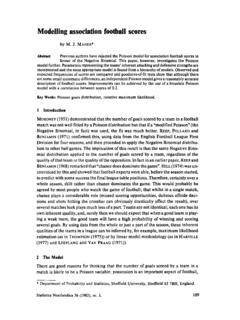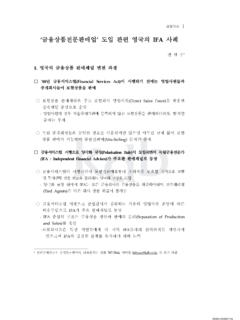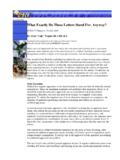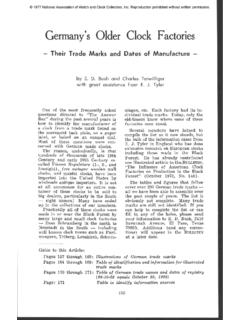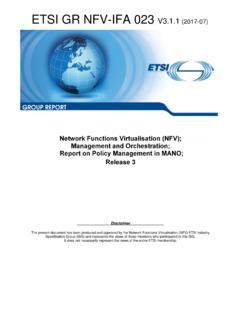Transcription of African swine fever (ASF) detection and diagnosis
1 A manual for veterinariansmanualISSN 1810-111919 FAO ANIMAL PRODUCTION AND HEALTHA frican swine fever (ASF) is a contagious viral disease that causes a haemorrhagic fever in pigs and wild boar, and is often associated with lethality of up to 100 percent. As a result, ASF can severely impact on the productivity of pig farming. This not only threatens food security and challenges the livelihoods of pig producers and other actors along the supply chain, but can also have major repercussions on international trade. With an extremely high potential for transboundary spread, the disease is today considered endemic in sub-Saharan Africa, Sardinia (Italy), and parts of the Caucasus and Eastern Europe. There exists a permanent risk of further spread of ASF from these areas due to the transboundary movements of individuals, pork products, fomites, and infected wild boar. Any country with a pig sector is at risk. The backyard sector, characterized by low biosecurity, is particularly the absence of any effective vaccine or treatment, the best strategy against ASF is to set up an early detection strategy, coupled with an early response mechanism for outbreaks.
2 In that context, the awareness and training of veterinary professionals and others in the front line will be purpose of this manual is to provide veterinary professionals, para-professionals, and laboratory diagnosticians with the information they need to promptly diagnose and react to an outbreak or case of ASF. Pig farmers, hunters and forest managers will also benefit from reading swine fever : detection AND DIAGNOSIS19 FAOA frican swine fever : detection and diagnosis9789251097526 Cover photographs: FAO/Daniel Beltr n-AlcrudoFAO ANIMAL PRODUCTION AND HEALTH manual19 FOOD AND AgRICULTURE ORgANIzATION OF THE UNITED NATIONsRome, 2017 African swine fever : detection AND DIAGNOSISA manual for veterinariansAuthorsDaniel Beltr n-AlcrudoFAOM arisa Arias and Carmina GallardoFAO Reference Centre, INIA-CISA, SpainScott A. KramerFAOMary-Louise PenrithUniversity of Pretoria, South AfricaAdditional contributorsAkiko Kamata and Lidewij WiersmaFAOThe designations employed and the presentation of material in this information product do not imply the expression of any opinion whatsoever on the part of the Food and Agriculture Organization of the United Nations (FAO) concerning the legal or development status of any country, territory, city or area or of its authorities, or concerning the delimitation of its frontiers or boundaries.
3 The mention of specific companies or products of manufacturers, whether or not these have been patented, does not imply that these have been endorsed or recommended by FAO in preference to others of a similar nature that are not views expressed in this information product are those of the author(s) and do not necessarily reflect the views or policies of 978-92-5-109752-6 FAO, 2017 FAO encourages the use, reproduction and dissemination of material in this information product. Except where otherwise indicated, material may be copied, downloaded and printed for private study, research and teaching purposes, or for use in non-commercial products or services, provided that appropriate acknowledgement of FAO as the source and copyright holder is given and that FAO s endorsement of users views, products or services is not implied in any requests for translation and adaptation rights, and for resale and other commercial use rights should be made via or addressed to information products are available on the FAO website ( ) and can be purchased through CitationBeltr n-Alcrudo, D.
4 , Arias, M., Gallardo, C., Kramer, S. & Penrith, 2017. African swine fever : detection and diagnosis A manual for veterinarians. FAO Animal Production and Health Manual No. 19. Rome. Food and Agriculture Organization of the United Nations (FAO). 88 viiiAcronyms ixIntroduction 1 ASF An overview 3 The pig sector 3 The AsF virus 4 Animals affected 5geographical distribution of AsF 5 Africa 6 Eastern Europe and the Caucasus 9 Previous ASF incursions outside of Africa 10 Transmission 11sylvatic cycle 11 Tick-pig cycle 12 Domestic cycle 13 Wild boar cycle 13 AsF transmission and resilience of the AsFV 14 Clinical presentation and postmortem findings 17 Peracute
5 18 Acute 18subacute 21 Chronic 22 Differential diagnosis 23 Classical swine fever (CsF) 23 Porcine reproductive and respiratory syndrome (PRRs) 23 Porcine dermatitis and nephropathy syndrome (PDNs) 23 Erysipelas 25 Aujeszky s disease 25salmonellosis (and other bacterial septicaemias) 26 Poisoning 27 Immediate actions at farm level in the event of a suspected outbreak 29 How to conduct an outbreak investigation 30 Interviews 32 Other sources of information 32 Biosecurity when visiting a farm 33ivWhen encountering suspected AsF in wild boar 36standard operating procedures (sOP) (gEMP, 2011) 37specialist diagnostic team (gEMP, 2011) 37 Sampling, packaging and transport of samples 39sampling 39 Types of sample 39 Packaging and transport of samples 42 Land transport 43 Transport by air 43 Transport of isolated/cultured ASF virus 47 Laboratory diagnosis of ASF 49 detection of AsF virus 50 ASFV genome detection by polymerase chain reaction (PCR) 50 ASF virus isolation 50 ASF antigen detection by direct fluorescent antibody test (FAT)
6 51 ASF antigen detection by antigen ELISA test 51 detection of AsF antibodies 52 ASF antibody detection by ELISA test 52 ASF antibody detection by indirect fluorescent antibody (IFA) test 53 ASF antibody detection by indirect immunoperoxidase test (IPT) 54 Prevention and control 57 Awareness 57 Prevention 59 Swill feeding 60 Containment of pigs 60 Cleaning and disinfection 61 Other biosecurity measures 62 Risk analysis and import/export procedures 63 Control 63 Emergency planning 64 Legal framework 65 Financing 65 Communication 66 Movement control 66 Stamping out and disposal 67 Cleaning and disinfection 68 Compensation 68 Restocking 69 Tick control 70 Wildlife control 70 Zoning and compartmentalization 71 Sources of assistance 73 References 75vLIST oF BoxeS1 Basic information
7 To be collected in the case of an emergency report on a disease outbreak (gEMP, 2011) 302 Tips when interviewing a farmer during an outbreak investigation 323 Equipment needed to ensure good biosecurity when entering a farm 334 sampling materials required 405 Minimum amounts recommended for target samples 426 Things to get ready/organize in advance 447 Plans and documents required in any comprehensive risk-mitigation and response system 648 Basic principles of emergency outbreak communication 66 LIST oF FIGUReS1 Number of pigs in the world by region (1961-2014) 32 global pig density per km2 43 The AsF virus close up 54 The global genotypic diversity of AsFV 65 African swine fever hosts 76 AsF status in domestic or wild hosts, as of April 2017 97 Three AsF virus transmission cycles 118 Warthog burrow 129 Wild boar in Europe 1410 Inactivating the AsF virus in swill 1611 Clinical forms of African swine fever according to the virulence of the isolate involved 1812 Clinical signs of acute African swine fever 1913 some of the most recognizable postmortem lesions of acute African swine fever 2014 Haemorrhagic lesions of acute African swine fever 2015 Further lesions of acute African swine fever 2116 Characteristic necropsy findings and clinical signs in wild boar affected with acute African swine fever 2117 Typical lesions observed in chronic forms of African swine fever 2218 Haemorrhages in a pig with classical swine fever (CsF)
8 24vi19 Enlarged haemorrhagic lymph node in a pig with highly pathogenic porcine reproductive and respiratory syndrome (PRRs) 2420 Pig suffering from porcine dermatitis and nephropathy syndrome (PDNs) 2521 Characteristic diamond-shaped skin lesions in a pig with erysipelas 2622 Piglet neurological issues due to Aujeszky s disease 2623 Pig suffering from salmonellosis with cyanotic ears 2724 Pig suffering from mycotoxin poisoning 2725 sampling of pigs in serbia 3126 Disinfection procedures at the farm 3427 Example of the triple packaging system for the packing and labelling of Category B infectious substances. 4528 Marking for infectious substances of Category B 4729 Marking for Miscellaneous dangerous substances 4730 Virus and antibody circulation in blood over time and in relation to the stage of AsF virus infection, as observed in European domestic pigs in Iberian Peninsula and Western Hemisphere (1960-1995) 4931 Haemadsorption reaction (HAD) 5132 Localisation of AsFV by immunofluorescence antibody test (FAT) in AsFV-infected tonsil 5233 AsF antibody detection by immunoblotting (IB) 5334 AsF antibody detection by indirect fluorescent antibody (IFA) test 5435 AsF antibody detection by indirect immunoperoxidase test (IPT)
9 5436 Training veterinarians on how to conduct a pig postmortem in signani, georgia 5837 Training pig farmers in Burkina Faso 5938 Examples of pig production systems with different levels of biosecurity 6139 Improperly discarded dead pig outside a farm in Kisumu, Kenya 6240 Roadblocks and signs limiting access to outbreak area and protection zone in Lithuania 6741 stamping out and disposal operations 6842 Removal and decontamination of AsF-suspected wild boar in Ignalina, Lithuania 71viiLIST oF TABLeS1 Ornithodoros ticks geographic distribution and role in the transmission of AsF 132 Resilience of AsFV across a variety of environmental conditions 153 Main clinical signs and postmortem findings observed in the different forms of AsF 214 summary of AsF differential diagnoses: clinical signs and postmortem differentials 285 African swine fever laboratory diagnostic techniques at a glance 55viiiAcknowledgementsThe editors and additional contributors are gratefully acknowledged in the con tributions would like to acknowledge the helpful comments and thorough review made by Berhanu Bedane (FAO), Klaas Dietze (Friedrich Loeffler Institute, Germany), Juan Lubroth (FAO), Marius Masiulis (EuFMD, FAO and the State Food and Veterinary Service, Lithuania), Samia Metwally (FAO) and Eran Raizman (FAO).
10 The manual was brought to life by photographs kindly provided by a number of excellent photographers from around the world. FAO would like to thank Daniel Beltr n-Alcrudo, Boehringer Ingelheim, John Carthy, China Animal Disease Control Center, Klaas Dietze, EuFMD, FLI, Carmina Gallardo, Marika Genzow, Pippa Hawes, IATA, INIA-CISA, Iowa State Diagnostic Laboratory, Philippe Le Mercier, Marius Masiulis, Torsten M rner, Mary-Louise Penrith, Ricardo P rez S nchez, Mikheil Sokhadze, Karl Stahl and VNIIVViM for offering their photographs for our illustrations, maps and tables were created by Ryan Aguanno (Figure 6), Daniel Beltr n-Alcrudo (Figure 6 and 7), Carmina Gallardo (Figure 4), INIA-CISA (Figure 30), Scott Kramer (Figure 7 and 11), Mary-Louise Penrith (Table 1), Claudia Pittiglio (Figure 6 and 9B) and the Complutense University of Madrid (Figure 30).Ryan Aguanno and Cecilia Murguia kindly assisted in producing the manual. Christopher Matthews edited and proofread the manual and Enrico Masci formatted the product.










